According to Gartner, by 2021 over 75% of midsize and large organizations will have adopted a multicloud or hybrid cloud IT strategy. The industry has evolved from being unsure about multicloud to widespread acceptance and having a clear strategic focus. To address the industry’s evolving needs, Oracle Cloud offers a comprehensive set of solutions in the form of specialized deployments, extensive monitoring capabilities, and strategic partnerships. In this blog, we cover these three aspects.
Specialized deployments: On the edge, on-premises, and in the public cloud
When it comes to cloud architecture, organizations have various requirements around performance, control, security, location, and so on. Oracle Cloud Infrastructure (OCI) fulfills customer needs by offering different deployments options with high performance, low latency, and comprehensive security measures.
Edge: Oracle Roving Edge
Oracle brings OCI capabilities closer to users and data-generating devices with its Roving Edge Infrastructure. At the center of the Oracle Roving Edge Infrastructure are Roving Edge Devices (REDs). Portable and scalable server nodes, REDs enable customers to operate cloud workloads in the field with low latency.

On-premises: Oracle Cloud@Customer
Sometimes, public cloud adoption isn’t a viable choice for businesses because of data sovereignty issues, performance concerns, or regulatory requirements. Oracle’s Cloud@Customer is a unique on-premises cloud offering that brings Oracle public cloud to customers. Identical to Oracle’s public cloud, Cloud@Customer comes with the same set of cloud services, service level agreements (SLAs), and security measures but runs exclusively from customer’s data center. This offering sets Oracle apart from the competitors because their public and private cloud offerings aren’t identical and have significant disparity. Using Cloud@Customer, organizations will have a strong control over their infrastructure and systems and can enjoy performance and cost benefits while fulfilling stringent data sovereignty requirements. Stated below are Oracle’s multiple offerings in Cloud@Customer.
Dedicated Region Cloud@Customer (DRCC)
Dedicated Region Cloud@Customer brings the same set of infrastructure and platform services as in Oracle public cloud and Oracle Fusion SaaS applications to customer data centers.
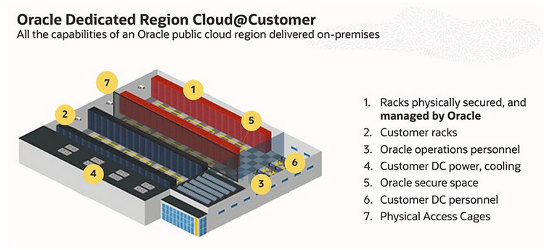
Based on a Gartner’s analysis on public and private cloud offerings of different cloud vendors, Oracle Dedicated Region Cloud@Customer was concluded as identical to Oracle’s public cloud and was referred to as the “sparkly pink unicorn.” Learn why Nomura Research Institute (NRI) and Australian Data Centres selected Dedicated Region Cloud@Customer to fulfill their business needs. For more information, visit DRCC.
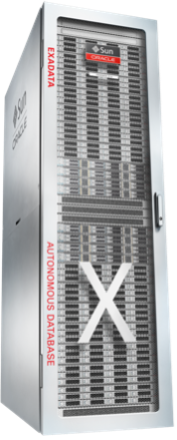
Autonomous Database on Exadata Cloud@Customer
It combines the high performance of Exadata with Oracle’s Autonomous Database and makes them available from customer data centers. For more information, visit Autonomous Database on Exadata Cloud@Customer.
Exadata Cloud@Customer
It brings the high performance of Exadata to customer’s data centers, while offering simplicity, cost reduction, and compatibility with other Exadata systems. For more information, visit Exadata Cloud@Customer.
Public: Oracle Cloud
Oracle Cloud offers a wide range of services in infrastructure (IaaS), platform (PaaS), and software (SaaS). Available in all 29 regions worldwide, it is rapidly growing and intends to have 36 regions by the end of 2021. As a next-generation infrastructure cloud, OCI is an enterprise-grade cloud, which offers elasticity and utility of public cloud with security and predictability of on-premises infrastructure. It has extensive set of platform services giving customers greater flexibility to build solutions tailored to their needs. Oracle has implemented emerging technologies, such as artificial intelligence (AI), machine learning (ML), blockchain, and internet of things (IoT) into its business applications and platform services for customers to innovate faster. Learn how State of Kansas used Oracle Cloud to modernize their infrastructure, implement a hybrid approach, and serve their citizens faster during COVID-19 pandemic.
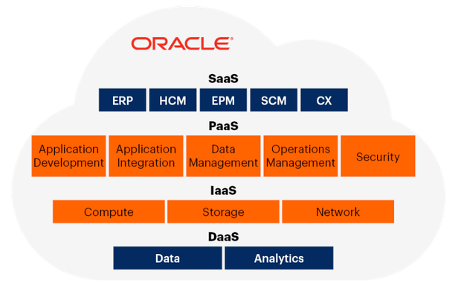
Oracle Cloud’s deep security capabilities in infrastructure, data, and applications, coupled with expanding compliance programs, such as ISO, SOC, GDPR, and FedRAMP, offer customers a more secure cloud and significantly improves their security posture. It stands distinguished from other public cloud vendors like AWS (view OCI vs AWS), Azure (view OCI vs Azure), and Google Cloud (view OCI vs GCP), with its autonomous services, service level agreements (SLAs), and cost and performance advantages. Customers can also estimate their costs and their savings. Gartner recently reported that “it’s time to include Oracle as a viable option when evaluating public cloud providers.”
Monitoring and manageability
Oracle Cloud Observability and Management Platform
In modern IT environments, different clouds are used for different workloads, making monitoring and manageability very challenging. Traditional siloed tools make IT staff tasks more complex when troubleshooting problems or correlating log data, especially when applications are hosted in multiple cloud environments.
To help the industry with these challenges, Oracle offers a complete solution called Oracle Cloud Observability and Management Platform (OMP). It provides deep visibility and machine learning driven insights across the entire stack deployed on any technology, anywhere. The platform improves manageability in multicloud environments and reduces operational complexity and risk. To expand the capabilities and enhance the experience, users can leverage OCI native services, such as Notifications, Functions, Events, and Streaming, with OMP. For more information, see Oracle Cloud Observability and Management Platform.
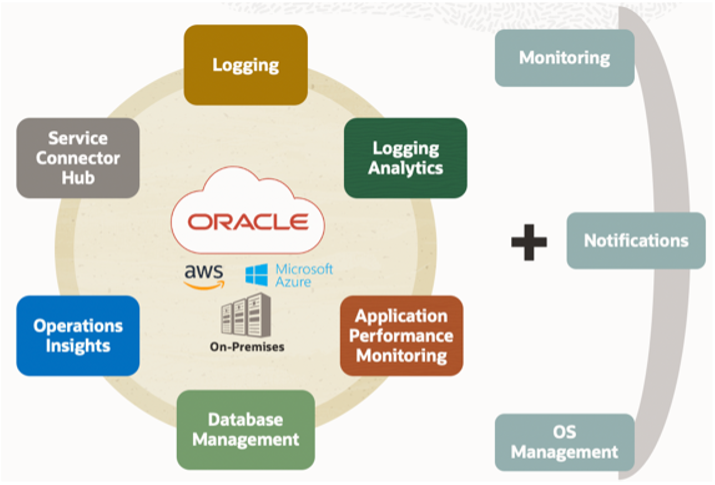
“With the release of the new Oracle Cloud Observability and Management Platform, Oracle delivers another industry first,” said Holger Mueller, vice president and principal analyst of Constellation Research. “This end-to-end approach for on-premises and multicloud management not only clearly benefits customers, but also provides an open platform for partners to plug in their offerings. The integrations with Grafana, PagerDuty, and Slack, and support for standards from the Cloud Native Computing Foundation, such as CloudEvents and OpenTracing, demonstrate Oracle’s commitment to interoperability.”
Strategic partnerships
Oracle and Microsoft
With the OCI and Microsoft Azure partnership, customers can enjoy interoperability between both clouds. It empowers customers to use the best from each cloud when looking to migrate or build new applications. Customers can run databases in OCI and utilize the benefits of Autonomous Database, while running applications in Azure and applying AI services. With low latency, fast interconnect, federated identities, and a collaborative support model between both clouds, customers can effectively run their multicloud strategy and innovate across the cloud. Oracle is committed to offering its customers flexibility and is growing the corresponding interconnected regions (recently added Frankfurt as the seventh region) across the globe. To learn more about Oracle Cloud and Microsoft Azure partnership, visit Oracle and Microsoft Accelerate Enterprise Cloud Adoption. For Azure-based solutions, see the documentation, and for OCI-based solutions, see the solution playbook.
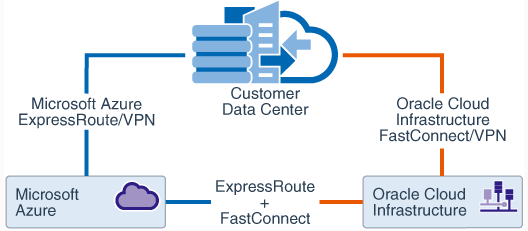
One of the largest telecommunication providers, TIM Brazil, is utilizing Oracle and Microsoft partnership to move all of their on-premises workloads to the cloud.
Oracle and VMware
According to IDC, VMware has an estimated 80% market share for on-premises virtualization software. Oracle and VMware have engineered a solution that makes it easier for customers to migrate their VMware environment to Oracle Cloud and enjoy the benefits of scale, security, and performance. The Oracle Cloud VMware Solution (OCVS) enables customers to create and manage VMware’s Software Defined Data Centers SDDCs on OCI. It makes a strong use case for hybrid cloud deployments and business continuity and disaster recovery. It offers complete control, a familiar VMware experience with the same tools and processes, a single view for hybrid cloud environments, and integration with other OCI solutions, such as Autonomous Database, Oracle RAC, and bare metal Compute instances.
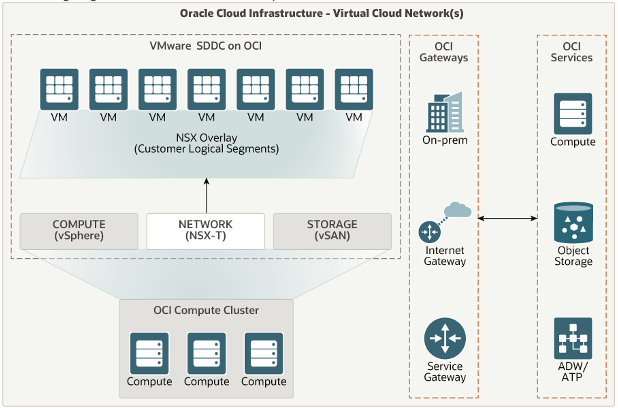
US Government customers can also use the solution with confidence because the Oracle Cloud VMware Solution is the first cloud native solution to achieve IL5 and Provisional Authority to Operate (P-ATO) at the High impact level from the FedRAMP Joint Authorization Board (JAB). To learn more about the Oracle Cloud VMware solution, see Oracle Cloud VMware Solution.
More Oracle advantages
Oracle on Oracle
A multicloud strategy gives companies the flexibility to use the best possible cloud for each workload. OCI’s second-generation cloud offers great performance and cost benefits to run different workloads, especially Oracle workloads. Based on an Accenture report, Oracle Database on OCI offers the best performance and best price for that performance. With different deployment options available by Oracle Cloud, customers have the flexibility to run their Oracle workloads based on their architectural and geographical needs. Also, Oracle has a plethora of migration tools that make it easy to move on-premises workloads to the cloud, while maintaining zero downtime and maximum availability. To learn more about how Oracle run best on Oracle, see Migrate On-Premises Oracle Applications to Oracle Cloud Infrastructure (OCI).
Oracle Enterprise Manager
With systems being deployed in different environments like, on-premises and cloud, customers can run into management and visibility issues. Oracle Enterprise Manager offers a single solution to customers for management and visibility of Oracle deployments in cloud and on-premises. With its new release, Oracle Enterprise Manager 13c release 5, customers can take advantage of new features like Hybrid Cloud Management, Ops Automation, and Extensibility. These new capabilities will help customers in administrating systems across on-premises and cloud environments with a single tool, automate management tasks, and extends interoperability with third party ecosystems. To learn more, visit Oracle Enterprise Manager.
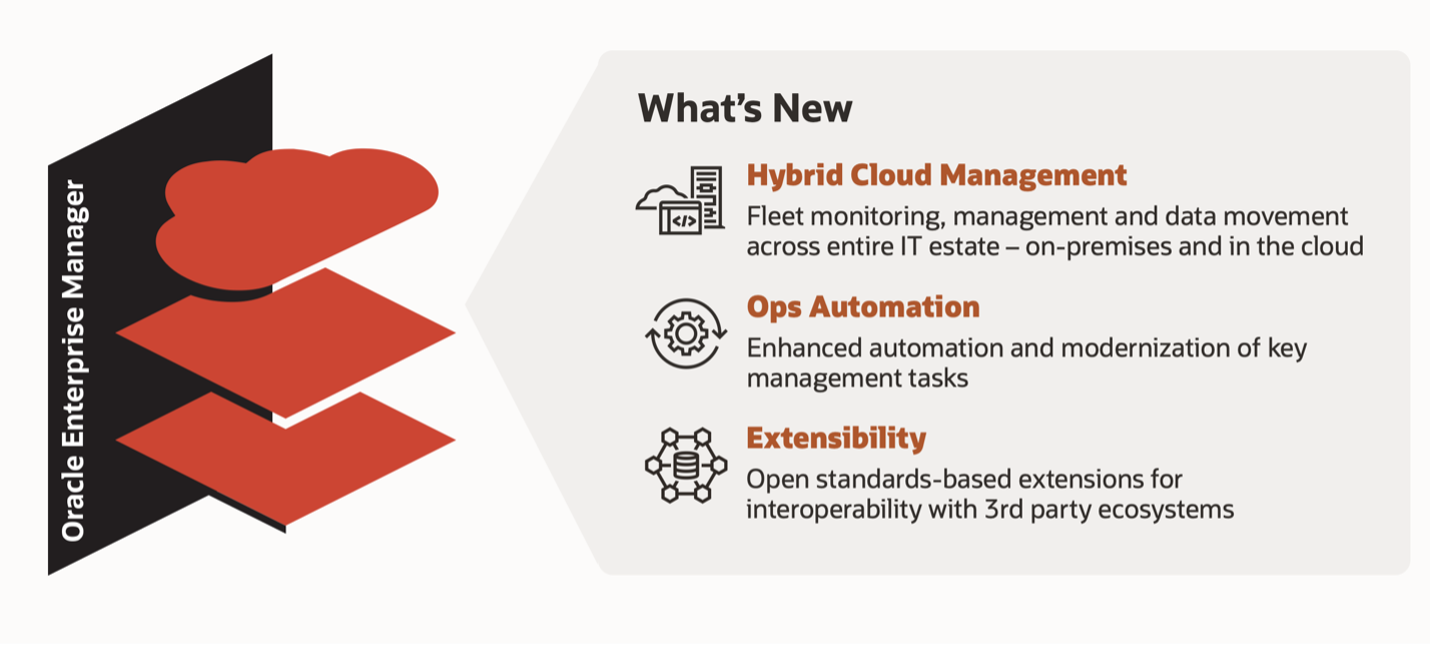
Oracle MySQL Database Service
MySQL is the world’s most popular open source database and is available in Oracle Cloud as MySQL Database Service. It’s 100% built, managed, and supported by MySQL team. It works natively with Oracle Generation 2 Cloud and is tightly integrated with Oracle technologies. Compatible with on-premises MySQL, it gives customers deployment flexibility and seamless transitioning between different environments like public cloud, hybrid cloud, or multicloud.
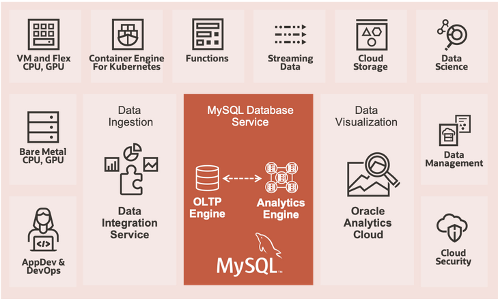
MySQL Database Service is the only MySQL Cloud service that offers the in-memory analytics engine, HeatWave, which can scale to thousands of cores and is 2.7 times faster than Amazon Redshift at one-third of the cost. It empowers the customers to run online transaction processing (OLTP) and online analytics processing (OLAP) workloads using a single MySQL database. MySQL Database service significantly reduces cost compared to AWS RedShift, AWS, RDS, and Microsoft Azure. For more information on MySQL Database Service, see MySQL Database Service.
Want to know more?
You can best address the reality of “no one size that fits all” by adopting a multicloud and hybrid cloud strategy. Organizations need to create a coherent cloud strategy and make smart cloud choices to fulfill their business needs. With Oracle’s decades of experience in software, hardware, databases, security, and deep understanding of enterprise needs, we’re uniquely positioned and committed to help businesses succeed in their cloud journey. Try OCI today for free.
